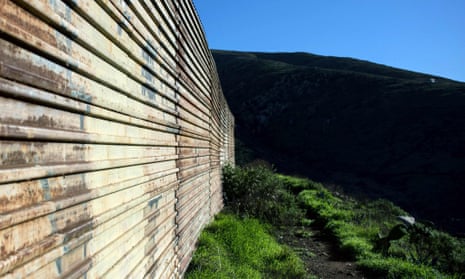The Trump administration is seeking nearly $18bn from Congress over the next decade to start extending and reinforcing a border wall with Mexico, the first financial blueprint for the president’s election campaign promise.
Details of the plan revealed on Friday would fund 316 miles of new barriers and bolster an additional 407 miles of existing barriers, adding up to a significant expansion of walls and fencing along the southwestern border.
US Customs and Border Protection (CBP), a branch of homeland security, submitted the details to Congress. Democrats and Republicans in Washington are gearing up for a fraught battle over the proposed wall and the status of young undocumented migrants, two issues that have become entangled and risk triggering a government shutdown on 20 January if no deal is reached.
Donald Trump electrified supporters during the 2016 election by promising to build a “big, beautiful wall” along the 2000 mile border with Mexico to keep out criminals and undocumented immigrants.
Currently there are about 650 miles of man-made physical barriers. CBP relies on sensors, cameras, patrols and natural barriers, such as rivers, to control the rest.
The administration’s proposal, first reported by the Wall Street Journal, would extend man-made barriers to cover half of the frontier by 2027.
AP reported that the document, which has not been made public, envisaged $5.7bn for towers, surveillance equipment and other technology; $1bn over five years for road construction and maintenance; and $8.5bn over seven years for 5,000 new border patrol agents, 2,500 border inspectors and other personnel. Barrier prototypes are being tested near San Diego.
ProfileWho are the Dreamers?
Show
Dreamers are young immigrants who would qualify for the Deferred Action for Childhood Arrival (Daca) program, enacted under Barack Obama in 2012. Most people in the program entered the US as children and have lived in the US for years “undocumented”. Daca gave them temporary protection from deportation and work permits. Daca was only available to people younger than 31 on 15 June 2012, who arrived in the US before turning 16 and lived there continuously since June 2007. Most Dreamers are from Mexico, El Salvador, Guatemala and Honduras and the largest numbers live in California, Texas, Florida and New York. Donald Trump cancelled the program in September but has also said repeatedly he wants Congress to develop a program to “help” the population.
The request complicated negotiations in Congress to grant legal status to about 700,000 young people known as Dreamers who were temporarily shielded from deportation under an Obama-era programme, Deferred Action for Childhood Arrivals.
Trump pulled the plug on Daca last year but gave Congress until March to come up with a deal to resolve the Dreamers’ status. Democrats have vowed to protect them from deportation – potentially giving Trump leverage to get Democratic support for the border wall.
However Richard Durbin, the ranking Democrat on the Senate immigration subcommittee, excoriated the administration’s proposed border plan.
“President Trump has said he may need a good government shutdown to get his wall. With this demand, he seems to be heading in that direction,” Durbin said in a statement.
“I’ve been clear from the beginning that Senate Democrats will consider reasonable border security measures in order to pass the Dream Act into law. The Trump administration set this crisis in motion when it ended Daca four months ago. It’s outrageous that the White House would undercut months of bipartisan efforts by again trying to put its entire wish-list of hardline anti-immigrant bills – plus an additional $18bn in wall funding – on the backs of these young people.”
The Senate minority leader, Chuck Schumer, and House minority leader, Nancy Pelosi, also oppose any immigration legislation or government funding plan that includes funding for a wall.
However, Democrats are under mounting pressure to pass legislation to shield Dreamers from deportation. Some immigration advocates and liberal groups have vowed to retaliate against Democrats who supported any spending bill to keep the federal government open that does not address the Dreamers issue.
Homeland security secretary Kirstjen Nielsen told the Associated Press earlier this week that the wall would be “first and foremost” in any package that protected Dreamers. She also said the administration wanted to close “loopholes” on the handling of asylum claims and local police forces cooperating with federal immigration authorities.
Earlier this week Immigration and Customs Enforcement (Ice), another branch of homeland security which detains undocumented migrants in the US interior, promised to “significantly increase” the number of deportation officers in California in response to the Democratic controlled state’s new “sanctuary state” law, which is meant to protect immigrants. “California better hold on tight,” acting Ice director Thomas Homan told Fox News.
